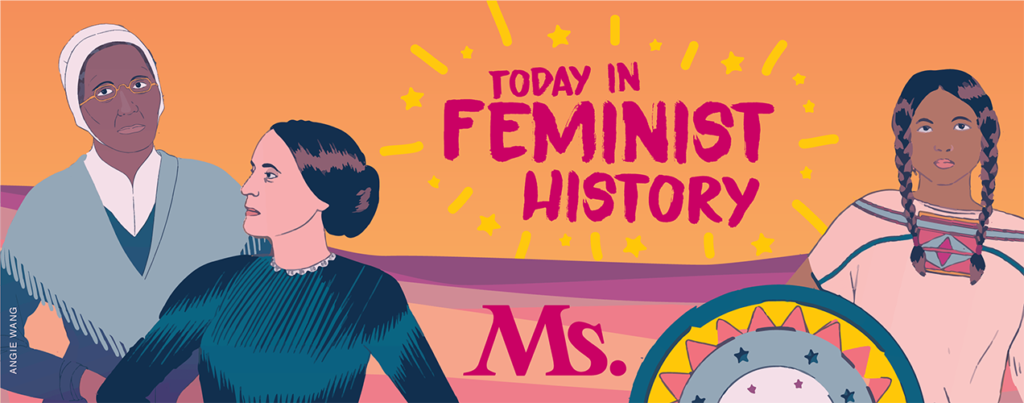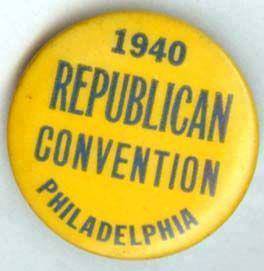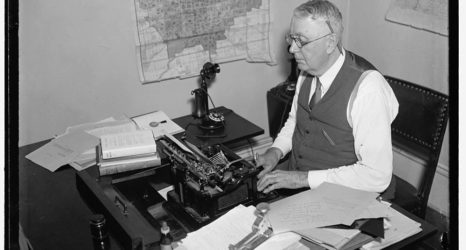
Today in Feminist History is our daily recap of the major milestones and minor advancements that shaped women’s history in the U.S.—from suffrage to Shirley Chisholm and beyond. These posts were written by, and are presented in homage to, our late staff historian and archivist, David Dismore.
June 26, 1940: “We favor submission by Congress to the States of an amendment to the Constitution providing for equal rights for men and women.”

With that simple sentence, the Equal Rights Amendment took a giant leap forward today, thanks to a decision just made by the Platform Committee, insuring that the Republican Party will become the first of the two major parties to include an E.R.A. plank in its platform when it’s formally adopted by convention delegates!
Just a little less than six months after the Susan B. Anthony (woman suffrage) Amendment was officially proclaimed to be the Nineteenth Amendment to the U.S. Constitution on August 26, 1920, the National Woman’s Party endorsed “absolute equality” as its next goal, and began the process of drafting legislation to bring it about.
On July 21, 1923, while celebrating the 75th anniversary of the Seneca Falls women’s rights convention of 1848, the N.W.P. formally endorsed a Constitutional amendment and a specific text (“Men and women shall have equal rights throughout the United States and every place subject to its jurisdiction”) and officially launched the campaign to have it adopted.
On December 10, 1923, the Equal Rights Amendment (also known as the “Lucretia Mott Amendment”) was formally introduced into the U.S. Senate by Senator Charles Curtis, Republican of Kansas. Three days later, Representative Daniel Anthony, also a Kansas Republican, introduced the House version of the resolution. Representative Anthony was a nephew of Susan B. Anthony, who voted a strictly Republican ticket when she “illegally” cast her one-and-only ballot in 1872.
The E.R.A. has been the subject of many Congressional hearings since the House Judiciary Subcommittee first took it up in February, 1924. It was given a favorable recommendation by both the House and Senate Judiciary Subcommittees in 1937, with the Senate Judiciary Committee reporting the measure to the full Senate in 1938 on a 9 to 9 tie vote.
The battle for the adoption of an E.R.A. plank in this year’s G.O.P. platform was ably led by the National Woman’s Party, whose founder, Alice Paul, wrote the amendment’s text. Though the N.W.P. was originally its only supporter, the E.R.A. now enjoys the endorsements of 16 national and 150 State and local organizations of women. Among the E.R.A.’s supporters are the National Federation of Business and Professional Women, which endorsed three years ago, and five State Federations of Women’s Clubs. The General Federation of Women’s Clubs is opposed, as is the League of Women Voters.
The chief concern of those who oppose the E.R.A. is that it will wipe out so-called “protective” legislation for women, laws which the National Woman’s Party sees as “restrictive,” and which make it harder for women to compete with men for jobs. A rival, much less comprehensive plank, was submitted last week to the Platform Committee by Jane Todd, which read: “The right to work for compensation shall not be abridged or denied by reason of race, religion, sex, economic or marital status.” Though the National Woman’s Party certainly agrees with the sentiments expressed in that resolution, this plank would have applied only to the workplace, and was primarily aimed at prohibiting employers from either refusing to hire – or from firing – married women, a long-standing phenomenon that became much more widespread after the Depression began in 1929.
Though representatives of the League of Women Voters called the Platform Committee’s decision to submit the E.R.A. resolution rather than the Todd resolution to the full convention “the shock of the century,” Doris Stevens, of the National Woman’s Party said: “Perfectly splendid. The party could do no less than recommend the guarantee of full rights under the Constitution to women everywhere.” Stevens gave special thanks to Alfred M. Landon of Kansas, the 1936 Republican Presidential nominee, who has reversed his previous opposition to the E.R.A., and she praised former Senator George Wharton Pepper of Pennsylvania for his strong support.
With the endorsement of the party whose legislators provided the votes needed to successfully put the 13th, 14th, 15th and 19th Amendments into the Constitution now assured, the battle will soon move to the Democratic Convention next month. Then it’s back to Congress to get the approval of 2/3 of the House and Senate, followed by a nationwide campaign to get 36 of the 48 State legislatures to ratify.
All that is no small task, but if in just 19 years things can progress from a general proposal for “absolute equality” legislation at a National Woman’s Party convention on February 16, 1921, to a specific Constitutional amendment that has been endorsed by numerous national, State and local organizations, and is now about to get the support of a major political party, the E.R.A. is clearly a powerful idea that’s unstoppable in the long run!





